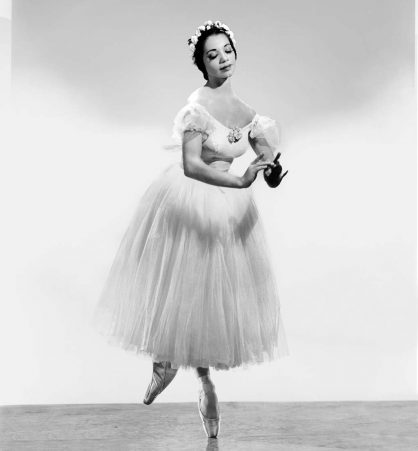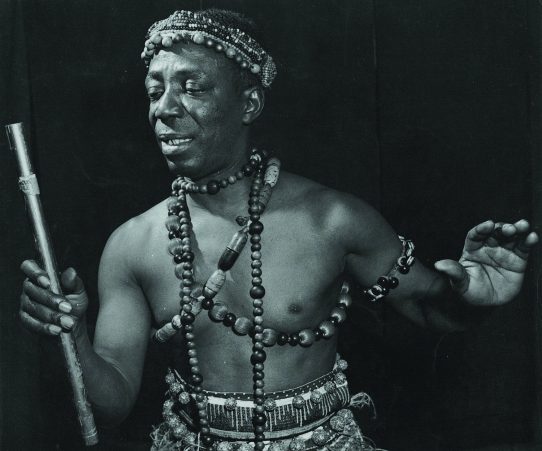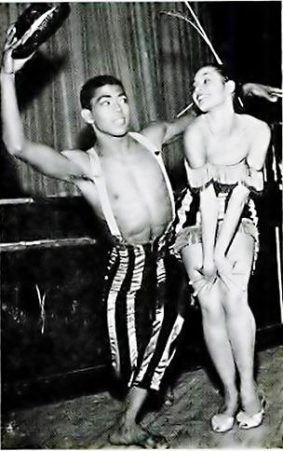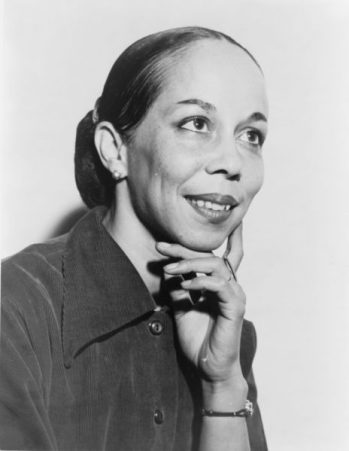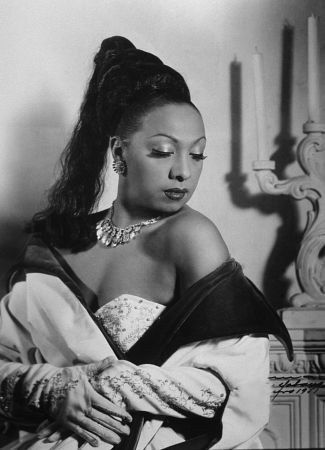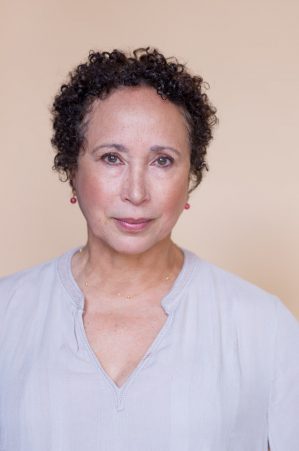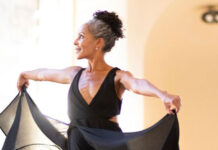These incredible dancers are among many Black performers, artists, choreographers, and activists who changed dance for everyone and made the arts more accessible to people of color.
1Anne Raven Wilkinson
Anne Raven Wilkinson (1935-2018) received a contract to dance with the Ballet Russe de Monte Carlo in New York City at 20 years old. She was the first African American woman to receive a contract with a major ballet company! As a young girl, Wilkinson learned ballet from dancers from Russia’s Bolshoi Theatre as well as with Madame Ludmilla Shollar (St. Petersburg Imperial Russian Ballet).
In 1954, Wilkinson began pursuing a professional career and was rejected by the Ballet Russe de Monte Carlo twice before being invited to join the company after her third audition. In the ballet, Wilkinson showed off her talents as a ballerina on stages across the country. However, due to increased racial discrimination from one of the ballet mistresses and dangerous interactions with audiences and even the Klu Klux Klan in southern cities, she decided to leave Ballet Russe in 1961.
After that, she auditioned with numerous companies including The School of American Ballet and the Met Opera Ballet with no success. “I think at the time I was almost a liability for a ballet company, given all that was happening and had happened to me in the South with the Ballet Russe. But I kept auditioning.”
She gave up dance in 1963, joining a convent in Wisconsin, but soon returned to the arts, receiving a soloist contract with the Dutch National Ballet in 1966. Seven years later, Wilkinson returned to the United States where she would go on to perform as an extra for the New York City Opera from 1974 until 1985.
Sources
- ANNE RAVEN WILKINSON (1935-2018) https://www.blackpast.org/african-american-history/wilkinson-anne-raven-1935/
- “A Conversation With Raven Wilkinson” http://www.balletreview.com/images/Ballet_Review_35-3_Raven_Wilkinson.pdf
2Asadata Dafora
Growing up in Sierra Leon, Asadata Dafora (1890-1965) grew up in a household filled with music since his mother was an accomplished musician who studied piano. This paired with Dafora’s interest in the dance, music, and storytelling of the indigenous cultures around him. This interest and his work studying opera at Milan’s La Scala Opera House led him to become a singer and later a dancer and choreographer when he moved to the United States in 1929.
Dafora worked as a concert singer in Harlem before later working to bring West African culture into American theater, not only bringing attention to these cultures but also breaking racist stereotypes about Black people that appeared in pop culture in the early 20th century. In 1933, he started two companies, the African Opera and Dramatic Company and Horton’s Dancers through which he produced his first full-length opera Zoonga which was originally introduced to audiences in Harlem. His next creation, Kykunkor or the Witch Woman brought him to the attention of critics in New York, including John Martin of the New York Times.
The first artist credited with bringing African traditions into choreography, Dafora inspired those that came after him to bring more cultural influences into American dance.
Sources
- “Dance of the African Diaspora: Asadata Dafora Robinson” https://danceinteractive.jacobspillow.org/themes-essays/african-diaspora/asadata-dafora/
- Dafora, Asadata https://www.anb.org/view/10.1093/anb/9780198606697.001.0001/anb-9780198606697-e-1802175
3Alvin Ailey
Alivin Ailey (1931-1989) fell for dance watching performances from Ballet Russe de Monte Carlo and the Katherine Dunham Dance Company when he was a tween. Inspired by those dancers, he moved to Los Angeles at the age of 12 and started taking dance classes in 1949 with Lester Horton, founder of one of the first racially-integrated dance companies in the United States and Ailey’s mentor.
Ailey became the director of the Lester Horton Dance Theater after Horton died in 1953. At that time, he also started choreographing original pieces and performing in Broadway shows. His work was inspired by Black church services, music, and experiences. Among his original work, Ailey choreographed around 80 ballets!
In 1958, he founded the Alvin Ailey American Dance Theater which would soon be joined by the Alvin Ailey American Dance Center/The Ailey School in 1969 and the Alvin Ailey Repertory Ensemble/Ailey II in 1974. His legacy continues to inspire and provide support for aspiring Black artists today.
Sources
- Alvin Ailey https://www.alvinailey.org/alvin-ailey-american-dance-theater/alvin-ailey
- Alvin Ailey https://www.biography.com/performer/alvin-ailey
4Bill “Bojangles” Robinson
Bill “Bojangles” Robinson (1878-1949) was born Luther Robinson. (Later in life, he forced his brother Bill to switch names with him because he didn’t like Luther.) As a child, he would also receive his lifelong nickname “Bojangles.”
Robinson’s parents, Maxwell and Maria Robinson, died in 1885, leaving Robinson to the care of his grandmother, Bedilia, a formerly enslaved woman. Around this same time, at the age of six Robinson started dancing in public for money, and by the time he was 12, he had left school to dance and joined a traveling company.
He would go on to perform in vaudeville shows as well as on Broadway and in numerous films including Shirley Temple’s 1930s productions. As a professional dancer, Robinson faced racism which often prevented him from performing outside of black venues, but he broke boundaries by starring in shows for white audiences such as Lew Leslie’s Blackbirds.
While Master Juba (William Henry Lane) brought early tap to the stage by combining traditional African rhythms with his footwork, Robinson is considered “The Father of Tap” for transforming the formerly flat-footed dance by tapping on his toes. Robinson’s beloved style carries on in tap even today, and in the United States National Tap Dance Day is May 25, Robinson’s birthday.
Sources
- Bill “Bojangles” Robinson https://www.biography.com/performer/bill-bojangles-robinson
- Bill “Bojangles” Robinson (1878-1949) https://www.blackpast.org/african-american-history/robinson-bill-bojangles-1878-1949/
5Debra Austin
At 16 years old, Debra Austin blazed a new trail by becoming NYCB's first-ever Black female Company member. This new @ReadElysian interview follows Debra's journey, from finding her raison d'être in the ballet studio to finding love onstage: https://t.co/NINdYojrHP pic.twitter.com/aHX6zA2e4q
— nycballet (@nycballet) February 5, 2021
Debra Austin is a ballet master and a founding member of the Carolina Ballet. When she was only 8 years old, her ballet teacher told her that she didn’t have the talent to be a ballerina. She was severely underestimated!
At 12 years old she received a scholarship to the School of American Ballet. At 16, she was invited by George Balanchine to join the New York City Ballet as the company’s first Black female company member. At NYCB, she danced in many principal roles including some created specifically for her by Balanchine.
Later in her career, Austin joined Switzerland’s Zurich Ballet also dancing in principal roles and toured Europe. When she returned to the United States, Austin joined the Pennsylvania Ballet as a principal dancer. There Austin became the first African American woman to be a principal ballet dancer for a major American ballet company.
Sources
- Debra Austin https://www.carolinaballet.com/debra-austin/
- Debra Austin https://readelysian.com/debra-austin/
- “Pioneering dancer proves her point(e)” https://www.newsobserver.com/entertainment/arts-culture/article89451022.html
6Janet Collins
Janet Collins (1917-2003) was born in New Orleans, but moved to Los Angeles as a child where she would later attend Los Angeles City College and the Los Angeles Art Center School. A painter and a dancer, Collins used her painting skills to make money to move to New York and become a professional dancer.
At just 15 years old, Collins was invited to join the Ballet Russe de Monte Carlo, but refused after being told she would have to paint her face white and hide her race during performances. She would later make her New York debut as a soloist in 1949. In 1951, she became the first Black artist to perform at the Metropolitan Opera in New York and join its company, and she was the Met’s first Black Prima Ballerina. After performing in Cole Porter’s Out of this World she received the Donaldson Award and was named the best dancer on Broadway.
In 1954, she left the Met and began touring as a solo artist in the United States and Canada and teaching at major dance schools like the School of American Ballet.
Sources
- “Celebrating Black History Month: Spotlight on Janet Collins” https://www.atlantaballet.com/news/celebrating-black-history-month-spotlight-on-janet-collins
- “Janet Collins, a Prima Ballerina” https://aaregistry.org/story/janet-collins-a-prima-ballerina/
7John W. Bubbles
The father of “soul tap” or “rhythm tap,” John W. Bubbles (born John William Sublett) (1902-1986) defined the tap dance traditions of dropping heels on offbeats and using toe taps to accent rhythms as well as extending rhythms beyond eight counts. As a child, he sang but switched to dance when his voice changed after puberty. He would later meet his performance partner “Buck” (Ford L. Washington) in a bowling alley.
Buck and Bubbles were first invited to perform when they were working as ushers in a Louisville theater. Buck played piano and sang while Bubbles danced. At the time, Black people were not able to enter many hotels, trains, or theaters, so the duo would disguise themselves to hide their identities from their audiences. Despite these limitations on their careers, they would go on to perform with the Ziegfeld Follies of 1931 and become the first Black artists to perform in Radio City Music Hall.
Bubbles is known for his talent as an improv dancer and for incorporating jazz styles into tap. A vaudeville star, he would also perform in several movies and live performances with other well-known dancers over the course of his career.
Sources
- “John Sublett Bubbles [biography]” http://memory.loc.gov/diglib/ihas/loc.music.tdabio.41/default.html
- John W. Bubbles: Tap & Jazz Legend https://scblog.lib.byu.edu/2019/02/07/john-w-bubbles-tap-jazz-legend/
- “John Bubbles, the Dancer, is Dead at 84” https://www.nytimes.com/1986/05/20/obituaries/john-bubbles-the-dancer-is-dead-at-84.html
8Josephine Baker
Josephine Baker (1906-1975) became an international star performing in the United States and Europe. She also worked as an activist and even a World War II spy. Raised by parents who were also entertainers, Baker was on stage from a young age. Life wasn’t easy for her though. When she was young, she would dance on the street for money when she couldn’t find work. This busking would later lead her to join an African American theater troupe at the age of 15.
From there, she became a vaudeville star and made her mark in the Harlem Renaissance before eventually moving to Paris where she was famous for her short skirts, modern dancing, and African themes. Baker performed on stage and in movies during her time in Europe, but she did eventually return to the United States where she fought racial discrimination by refusing to perform for segregated audiences and speaking at the 1963 March on Washington for Jobs and Freedom.
Remembered for her talents as a performer and her work to bring equality and social justice to Black people around the world, the NAACP named May 20 Josephine Baker Day in her honor.
Sources
- “The Josephine Baker Biography: Story Of A Dancer” https://theculturetrip.com/europe/france/paris/articles/the-josephine-baker-biography-story-of-a-dancer/
- Josephine Baker https://www.womenshistory.org/education-resources/biographies/josephine-baker
9Misty Copeland
Misty Copeland is well known as the first African American female principal dancer with the American Ballet Theatre, and her work to encourage Black children to feel beautiful and talented and chase their dreams has inspired millions. Misty Copeland’s journey started when she started taking ballet at 13. She studied at the San Francisco Ballet School and American Ballet Theatre’s Summer Intensive.
At just 18 years old, Copeland joined ABT’s corps de ballet, and six years later, she was promoted to a company soloist–the second African American female soloist in ABT’s history (Anne Benna Sims was the first). In 2015, she was promoted to principal dancer, the first African American woman to be promoted to the position since the company was formed 75 years earlier.
As a dancer, a writer, a model, and a mentor, Copeland has brought dance and ballet to non-dancers, and made it her mission to make classical dance more equal and diverse.
Sources
- Misty Copeland https://mistycopeland.com/about-2/
- Misty Copeland https://www.abt.org/people/misty-copeland/
10Virginia Johnson
Virginia Johnson grew up in Washington, D.C., and started taking ballet at the age of 3 under the guidance of her mother’s friend Therrell Smith. In love with the music and the art of ballet, Johnson worked hard to develop her technique and went on to graduate from the Academy of the Washington School of Ballet.
While at New York University, she learned that Arthur Mitchell was teaching ballet classes in Harlem. She dropped out of NYU’s School of the Arts to take his classes which would later lead to her becoming a founding member of the Dance Theater of Harlem and Prima Ballerina. Throughout her career, she worked to prove that anyone, regardless of race, can do ballet with the right support.
Johnson was a principal dancer for almost 30 years. After her retirement, she founded Pointe Magazine where she was editor-in-chief for 10 years. She is the artistic director of the Dance Theatre of Harlem.
Sources
- Virginia Johnson https://www.dancetheatreofharlem.org/people/virginia-johnson/
- “Meet Virginia Johnson: From Prima Ballerina to Dance Theatre of Harlem Artistic Director” https://www.pbt.org/blog/meet-dance-theatre-harlems-virginia-johnson/


